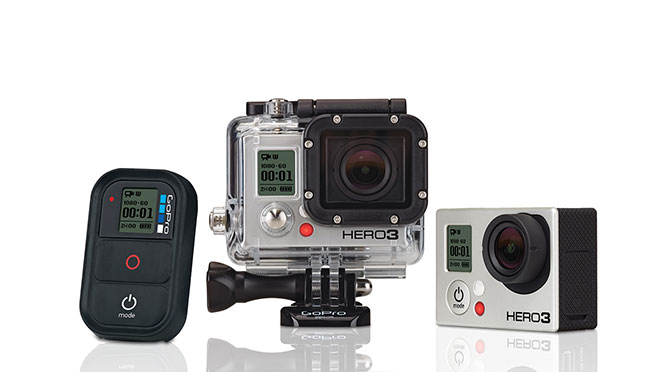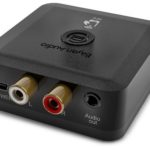
Review: GoPro 3 Black Edition
Posted on Apr 16, 2013 by Alex Fice
GoPro has infused a new market for camera rigs and accessories and supposedly sold more 3s in 2 months than the total of 2s!
GoPro know when they are on to a good thing. Pretty much everyone who jumps out of an aircraft, surfs a tube, dives a coral reef, or races using internal combustion will have a GoPro glued to them somewhere – at least, if they are being followed around by a film crew.
So it’s no great surprise that the GoPro Hero 3 is a bit like the GoPro Hero 2 – only better – no one wants to change a winning formula.
Of course, with very few exceptions, smaller is always better – so the first thing you notice unpacking a Hero 3 is that it has shrunk in all three dimensions, perhaps most noticeably front to back. Smaller also means lighter – of particular significance if you have one bolted to your helmet in any kind of strenuous activity. Other than the size, the general format is the same as before – a simple rectangular, predominantly plastic box with a protruding, wide-angle lens which nestles snugly in a sturdy, waterproof, polycarbonate case. This case is where you notice the first of the improvements.
Although rated to a water depth of 60 metres, the old GoPro case suffered from a significant problem – the old, domed port over the lens resulted in a change in focus when underwater. It was slight, but meant it was often impossible to get images as sharp as you would like. The new port is flat – so it shouldn’t suffer from this problem. The port also has a black surround that snuggles around the black lens mount of the camera – presumably to help reduce reflections and flare.
One thing the case still lacks is any kind of tripod mount. Of course, you get all the stick on, suck on and strap on mounts of the old Hero, but surely I can’t be the only person who would like a threaded bush?
There are three models of the camera – a plain vanilla ‘White’, the ‘Silver’ which is the lowest model to offer Protune (see later) and the ‘Black’, which is the most desirable, offering 1080p at 60fps, 2k, higher resolution stills and a better lens. It even offers 4k, but only at 15fps. This was the version we reviewed.
GoPros of old certainly weren’t renowned for their subtle image quality – generally you got over-saturated, contrasty images with little black or highlight detail. Whilst this ‘setting’ is still available, perhaps the most useful feature of the Hero 3 is Protune. Select this option (using the simple but slightly infuriating user interface) and your CODEC data rate goes up to 45Mbits/s (maxed out on the Black at 1080p60). A colour profile and gamma value is also selected to give a low contrast, low saturation image, ideal for easier grading. The difference between this and a Hero 2 is astonishing. There is a lot less noise in the image – the Hero 2’s lower bitrate CODEC seemed to accentuate the noise from the sensor – and the benefit to the tonality of the footage alone is worth the upgrade to these new cameras. There still isn’t any control of exposure, but you can now select a white balance value (or stick with auto).
There are other benefits to the new Hero 3 too.
Although the Hero 3 range still doesn’t include an LCD screen as standard, you do get WiFi built in. This can be used to connect to a groovy little remote control – it looks like a key fob for a small family car – and owners of Android or Apple IOS devices can control their camera from a free app. The camera will stream live video to the app, so you can use it as a remote viewfinder. Sadly, there is quite a lag in the displayed video – about a couple of seconds – and you lose the feed once you go into record, and you can’t play back recorded footage, but come on! It’s a remote monitor on a £360 camera – though the Drift Innovation HD Ghost does the same, with less lag.
Speaking of which, there are now quite a lot of competitors for GoPro – some of them, like the HD Ghost, are very good. Protune, though, has returned the edge to the Hero 3 in terms of image quality. If you are willing to pay the extra for the Black edition, being able to shoot slow-mo at 1080p is also pretty compelling for an action camera.
It’s not all good news though. The review camera crashed several times – once during record – requiring removal and replacement of the battery to recover. I would be very cross if I had to jump out of an aeroplane twice because the camera crashed the first time. Actually – I would be cross having to jump out of an aeroplane at all. Having said that, the unit may have suffered at the hands of other journalists before me – the battery was also in a bad way and wouldn’t hold charge overnight.
The GoPro Hero 3 is a worthy successor to the Hero 2. It’s smaller and lighter – important for an action camera – its image quality in Protune mode is a vast improvement and the built-in WiFi/smartphone remote control is handy, to say the least.













